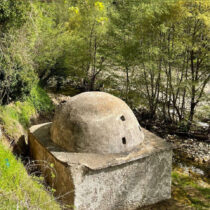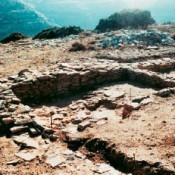Eric Higgs came to Archaeology after an earlier career in a different subject. Being at the Museum of Archaeology and Ethnography in Cambridge, he was attracted to Prehistory, and particularly the Palaeolithic. In the late 1950’s much work had been done on the classi-ficasion of the Palaeolithic in Europe, which was based largely on available data from central and western Europe, since at this time there was only minimal evidence for Palaeolithic traces in Greece. Eric Higgs saw that there were obvious analogies between North Africa and the Greek region and proposed the theory that there might be evidence for Palaeolithic activity in Greece; and that Greece ought to form a geographical link between Africa and Europe. Thus, he started to research in order to locate Palaeolithic sites in Greece. The results of this survey were published in the Proceedings of the Prehistoric Society of England in 1964. The method applied was to comb the surveyed area, sampling whatever was relevant to the research. Higgs, with the eager support of Sotiris Dakaris, conducted excavations in the Agios Georgios area, north of Preveza, which produced flint finds and handaxes.
The investigation continued during the period from 1962 to 1967, with surveys and excavations at Aspro-chaliko and Kastritsa as well as at Kokkinopilos. Higgs was able to establish and define chronologically the sequence of stone workshops in Epirus. Higgs’ achievements, not only in Epirus, but in his whole approach to the field of Prehistory, received full recognition with his appointment in 1967 as Director of the British Academy’s major research project on the Early Prehistory of Agriculture.
Hjggs interpreted the context of his discoveries in the light of the present practice of seasonal migration, demonstrated by the Sarakatsani shepherds in Epirus. The interpretation principles which supported his ideas remain fundamental: it is essential, that is, the archaeological sites and the material which comes from them to be interpreted in terms of the environment to which they belonged; and imperative, as regards the Palaeolithic period, to be properly appreciated that the ancient environment would have been radically different from the present one. Also, that this interpretation should not be restricted to the immediate surroundings, but that it should be extended to the broader environment as an element of great significance. Higgs pioneering work gave the initial impetus to the study of Palaeolithic period in modern Greece. It is particularly in this respect that this issue of Αρχαιολογία και Τέχνες is a fitting tribute to Eric Higgs’ achievements.



